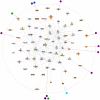Genome-wide identification of susceptibility alleles for viral infections through a population genetics approach
- PMID: 20174570
- PMCID: PMC2824813
- DOI: 10.1371/journal.pgen.1000849
Genome-wide identification of susceptibility alleles for viral infections through a population genetics approach
Abstract
Viruses have exerted a constant and potent selective pressure on human genes throughout evolution. We utilized the marks left by selection on allele frequency to identify viral infection-associated allelic variants. Virus diversity (the number of different viruses in a geographic region) was used to measure virus-driven selective pressure. Results showed an excess of variants correlated with virus diversity in genes involved in immune response and in the biosynthesis of glycan structures functioning as viral receptors; a significantly higher than expected number of variants was also seen in genes encoding proteins that directly interact with viral components. Genome-wide analyses identified 441 variants significantly associated with virus-diversity; these are more frequently located within gene regions than expected, and they map to 139 human genes. Analysis of functional relationships among genes subjected to virus-driven selective pressure identified a complex network enriched in viral products-interacting proteins. The novel approach to the study of infectious disease epidemiology presented herein may represent an alternative to classic genome-wide association studies and provides a large set of candidate susceptibility variants for viral infections.
Conflict of interest statement
The authors have declared that no competing interests exist.
Figures

References
-
- Lander ES, Linton LM, Birren B, Nusbaum C, Zody MC, et al. Initial sequencing and analysis of the human genome. Nature. 2001;409(6822):860–921. - PubMed
-
- Beutler B, Eidenschenk C, Crozat K, Imler JL, Takeuchi O, et al. Genetic analysis of resistance to viral infection. Nat Rev Immunol. 2007;7(10):753–766. - PubMed
-
- Limou S, Le Clerc S, Coulonges C, Carpentier W, Dina C, et al. Genomewide association study of an AIDS-nonprogression cohort emphasizes the role played by HLA genes (ANRS genomewide association study 02). J Infect Dis. 2009;199(3):419–426. - PubMed
Publication types
MeSH terms
LinkOut - more resources
Full Text Sources
Other Literature Sources
Medical

